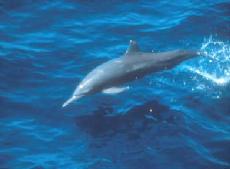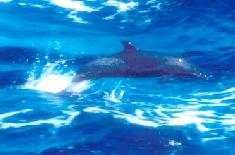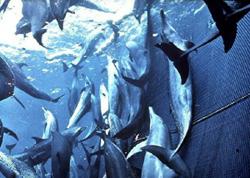|
But according to the report by the Southwest Fisheries Science Center, part of the National Marine Fisheries Service and an agency of the Commerce Department, dolphins in the Pacific are not making the recovery that the dolphin safe labeling restrictions were expected to promote. In fact, the report suggests, some populations of dolphins may still be declining, despite evidence that the accidental snaring of dolphins, known as bycatch, by tuna fishers has reportedly dropped to less than 3,000 dolphins per year.
"Despite considerable scientific effort by fishery scientists, there is little evidence of recovery, and concerns remain that the practice of chasing and encircling dolphins somehow is adversely affecting the ability of these depleted stocks to recover," the study states.
The 96 page internal report, "Report of the Scientific Research Program Under the International Dolphin Conservation Program Act," is dated August 23, 2002, but had not been released to the public. The nonprofit environmental education group Earth Island Institute has posted a leaked copy of the report on its website at: http://www.earthisland.org/immp/secret_report.pdf
The report, an accumulation of government research conducted from 1997 to 2002, shows that dolphin populations in the Pacific remain depleted, with eastern spinner dolphins at 35 percent of their historic levels, and northeastern offshore spotted dolphins at just 20 percent of their former numbers.
"For the first time, NMFS has officially acknowledged the massive and previously uncounted killing of baby dolphins that are separated from their mothers during chase and capture by tuna vessels using mile long nets," said David Phillips, director of Earth Island Institute's international marine mammal project. "This is a shocking and tragic revelation."
The northeastern offshore spotted dolphin is
at just 20 percent of its historic levels.
According to one analysis cited by the Earth Island Institute, it would take 65 years for eastern spinner dolphins to recover, while depleted northeastern offshore spotted dolphins would take 78 years to recover. Another analysis suggests that neither species would recover even after 200 years, the Institute notes.
The authors of the report offer three possible explanations for the dolphins' lack of recovery, including: environmental changes that reduce the number of dolphins the habitat can support; delayed recovery despite the reduction or elimination of dolphin bycatch; or effects of tuna fishing that reach beyond the impacts of bycatch.
For example, the report notes that the fishing methods favored by commercial tuna fisheries in Mexico, Venezuela, Colombia and other nations may stress dolphins, even when they are not caught in nets, or when they are released from nets alive. Many of the region's tuna fishers chase down schools of dolphins in order to target the tuna on which the dolphins feed, than encircle the tuna with nets that can also ensnare dolphins.
At least an additional six to 10 percent of eastern spinner dolphin mortality, and 10 to 15 percent of northeastern offshore spotted dolphin mortality, is caused by the separation of baby dolphins from their mothers during the chasing and netting process, the report finds.
The report cites figures showing that tuna fishers set nets on schools of dolphins an estimated 5,000 times a year, resulting in the pursuit of 6.8 million dolphins and the netting of two million dolphins.
Individual eastern spinner dolphins in the eastern
tropical Pacific are chased an average of 5.6 times
a year, and captured an average of 0.7 times a year.
Northeastern offshore spotted dolphins are chased
10.6 times a year and captured 3.2 times a year.
The report states that physiological stress of these
encounters with fishers results in decreased births,
impaired health and the deaths of dolphins, offering
a "plausible" explanation for the lack of recovery of
depleted dolphin populations.
|


